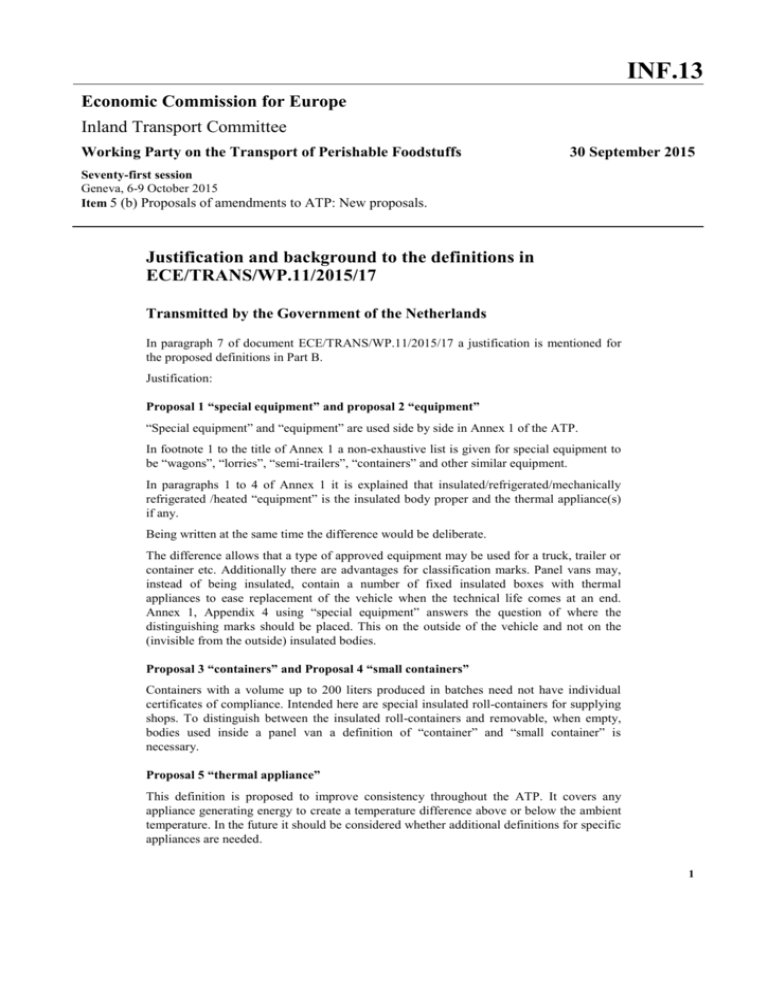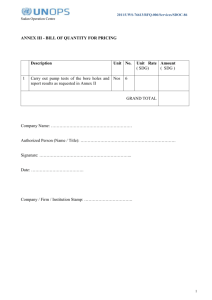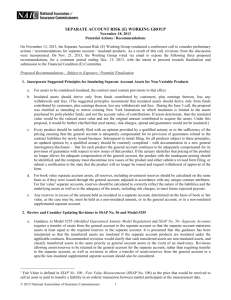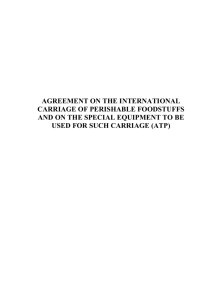INF.13 Economic Commission for Europe Inland Transport
advertisement

INF.13 Economic Commission for Europe Inland Transport Committee Working Party on the Transport of Perishable Foodstuffs 30 September 2015 Seventy-first session Geneva, 6-9 October 2015 Item 5 (b) Proposals of amendments to ATP: New proposals. Justification and background to the definitions in ECE/TRANS/WP.11/2015/17 Transmitted by the Government of the Netherlands In paragraph 7 of document ECE/TRANS/WP.11/2015/17 a justification is mentioned for the proposed definitions in Part B. Justification: Proposal 1 “special equipment” and proposal 2 “equipment” “Special equipment” and “equipment” are used side by side in Annex 1 of the ATP. In footnote 1 to the title of Annex 1 a non-exhaustive list is given for special equipment to be “wagons”, “lorries”, “semi-trailers”, “containers” and other similar equipment. In paragraphs 1 to 4 of Annex 1 it is explained that insulated/refrigerated/mechanically refrigerated /heated “equipment” is the insulated body proper and the thermal appliance(s) if any. Being written at the same time the difference would be deliberate. The difference allows that a type of approved equipment may be used for a truck, trailer or container etc. Additionally there are advantages for classification marks. Panel vans may, instead of being insulated, contain a number of fixed insulated boxes with thermal appliances to ease replacement of the vehicle when the technical life comes at an end. Annex 1, Appendix 4 using “special equipment” answers the question of where the distinguishing marks should be placed. This on the outside of the vehicle and not on the (invisible from the outside) insulated bodies. Proposal 3 “containers” and Proposal 4 “small containers” Containers with a volume up to 200 liters produced in batches need not have individual certificates of compliance. Intended here are special insulated roll-containers for supplying shops. To distinguish between the insulated roll-containers and removable, when empty, bodies used inside a panel van a definition of “container” and “small container” is necessary. Proposal 5 “thermal appliance” This definition is proposed to improve consistency throughout the ATP. It covers any appliance generating energy to create a temperature difference above or below the ambient temperature. In the future it should be considered whether additional definitions for specific appliances are needed. 1 INF.13 Proposal 6 “removable” and Proposal 7 “non –independent” Only in Annex 1, Appendix 4 can an explanation be found of what is intended by these terms. With the future introduction of an additional test for non-independent equipment in Annex 1, Appendix 2 an explanation in a more logical place is necessary. The need for a definition of “non-independent” can also be seen in the use of the terms “dependent” or “non- autonomous” in different official documents. Proposal 8 “Multi temperature multi compartment" There is already some explanation in Annex 1 Appendix 2. “Multi temperature multi compartment” is a very specific type of equipment where the overall body has to be heavily insulated. This should not be confused with special equipment consisting of more than one insulated bodies such as semi-trailers with an upper and lower deck with different levels of insulation. To have as clear a definition as possible a note was added to explain the exemptions such as special equipment consisting of two or more individual approved bodies. Proposal 9 “partition” With the adoption of section 8 in Annex 1, Appendix 2, the new terms “bulkhead” and “internal dividing wall” were introduced which address the same function as “partition” which was already in the ATP in paragraph 2.2.1 of Annex 1, Appendix 2. A “bulkhead” is a more marine related expression for a watertight division between the load space and other spaces. Partition is already used in the ATP and it is understood that the load can be either side. This term was favoured. Proposal 10 “compartments” This definition intends to give more explanation that compartments can be fixed or flexible, even two compartments that can become one. The last condition can be helpful in understanding multi-temperature multi-compartment equipment. 2







